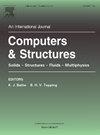电致伸缩粘-超弹性作动器及发电机的数值研究
IF 4.8
2区 工程技术
Q1 COMPUTER SCIENCE, INTERDISCIPLINARY APPLICATIONS
引用次数: 0
摘要
在这项研究中,我们开发了一个能够评估电伸缩对介电弹性体的静电、有限变形和粘弹性响应的影响的数值框架。利用虚功原理推导了控制方程及其弱形式。粘弹性建模采用齐纳流变模型。粘弹性介质弹性体的本构方程考虑了电致伸缩效应。本文的应用包括三维扭转作动器和圆膜片发生器。这些应用的非均匀位移场和复杂的几何结构需要使用有限元方法。根据实际应用,设计并验证了两种类型的单元:三维单元和轴对称单元。研究了粘弹性中粘度参数和加载速率这两个决定因素对电致伸缩时执行器响应的影响。结果表明,在考虑致动器性能和工作电压的电致伸缩后,有了显著的改进。研究了不同粘度参数下电伸缩对发电机能量收集周期的影响,结果表明,电伸缩系数越负(正),机械和电气功越大(小),循环效率越低(高)。本文章由计算机程序翻译,如有差异,请以英文原文为准。
A numerical study on electrostrictive visco-hyperelastic actuators and generators
In this research, we develop a numerical framework capable of evaluating the electrostriction effect on the electrostatic, finite deformation and viscoelastic response of dielectric elastomers. The principle of virtual work is employed to derive the governing equations and their weak form. The Zener rheological model is adopted for viscoelastic modeling. The constitutive equations incorporate the electrostriction effect into viscoelastic dielectric elastomers. The applications of this paper include a 3D torsional actuator and a circular diaphragm generator. The inhomogeneous displacement fields and complex geometry of these applications necessitate the use of the finite element method. Based on the applications, two types of elements are designed and verified: a 3D element and an axisymmetric element. The effects of two decisive factors in viscoelasticity, i.e., the viscosity parameter and the loading rate, are studied on the response of the actuator in the presence of electrostriction. The results demonstrate significant improvements by accounting for electrostriction in both actuator performance and operating voltage. Investigating the effect of electrostriction on the energy harvesting cycle of the generator with various viscosity parameters reveals that a more negative (positive) electrostrictive coefficient results in greater (smaller) mechanical and electrical work and lower (higher) cycle efficiency.
求助全文
通过发布文献求助,成功后即可免费获取论文全文。
去求助
来源期刊

Computers & Structures
工程技术-工程:土木
CiteScore
8.80
自引率
6.40%
发文量
122
审稿时长
33 days
期刊介绍:
Computers & Structures publishes advances in the development and use of computational methods for the solution of problems in engineering and the sciences. The range of appropriate contributions is wide, and includes papers on establishing appropriate mathematical models and their numerical solution in all areas of mechanics. The journal also includes articles that present a substantial review of a field in the topics of the journal.
 求助内容:
求助内容: 应助结果提醒方式:
应助结果提醒方式:


